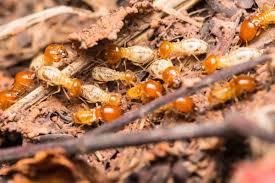Examine This Report on Termite Control For House
Reproductives that are darker in colour to castes, have functional eyes and robust skin. This caste becomes the leaders of future colonies.
The temperature, food grade, and activity of this colony will determine how long it takes to get a termite to develop from egg to adult.
Nests and tunnels are stored moist because worker termites cannot stand low humidity for long intervals. The temperature within the nursery of a massive nest ranges between 10 C and 35 C but varies more than one level a day. The relative humidity is approximately 100 per cent.
It is important to identify the type of pest termite before beginning treatment. This can allow you to understand the customs of the colony, find the nest and indicate the most suitable method of control.
Not known Details About Termite Control For House
Termite species are best identified with their soldier termites, which has got the most prominent features.
These termites are commonly distributed throughout Victoria, and are responsible for more than 80 per cent of irreparable harm to buildings.

Coptotermes construct nests in trees (preferring eucalypts), stumps, under concrete flooring, in wall cracks or enclosed verandahs.
Getting The Termite Control For House To Work
These termites traveling at least 50 metres from the colony using a series of underground tunnels to find food. Coptotermes acinaciformis send large numbers to new food resources and, therefore, respond strongly to lure. In contrast, Coptotermes frenchi research for new food sources and feed at points.
Nasutitermes exitiosus is common north of the Great Dividing Range. They construct dark, thin-walled mound nests between 30 cm and 75 cm above ground. These mounds are up to 1m in diameter.
This is Victorias largest species of termite called termite. They are usually found nesting in large pieces of wood (especially older trees) and are most common in moist, mountainous locations. They may, however, also be found in the foothills of Melbourne.
The smart Trick of Termite Control For Lawns That Nobody is Discussing
Porotermes tend to reside in smaller colonies than other species, and do not construct shelter tubes or traveling far underground. They're more readily controlled than other species.
A mature colony of Schedorhinotermes will possess two distinct sizes of soldiers, referred to as major and minor soldiers. Important soldiers grow up to 5.6 mm long, while minor soldiers are only 3.6 mm long. Both kinds of soldier have mandibles.
Schedorhinotermes are harmful and relatively nomadic, rather than maintaining a fixed, central nest.
Some Known Details About Termite Control For New Construction
Heterotermes are distributed throughout Australia. However, they are only a significant pest species in the Northern Territory.
The soldiers of the species are around 4.75 mm long, with lengthy, dark jaws and parallel-sided heads.
Heterotermes reside in small colonies which assault fence posts, wood flooring, and paling fences within a small radius of the nest. They are commonly found because they feed on small timbers on the soil surface.
Dusts work to control termites since they ingest and distribute the insecticide among the colony during habitual grooming.
Termite Control For Lawns for Beginners
Insect growth-regulator dusts (such as Triflumuron) and non-repellent termiticides are the most powerful methods of termite pest control for the human consumer.
Arsenic trioxide dust has been used since the 1930s to control termites, often with the addition of ferric oxide or another colourant. But, arsenic trioxide is a poisonous, highly toxic elemental pesticide that does not degrade.
Everything about Termite Control For House
Baiting is most often the best way to kill an attacking colony when the main nest site cannot be found. Bait stations also allow you to collect samples of termites for species identification.
Bait stations consist of containers of cellulose materials like timber, paper or cellulose gel that are either buried in the ground near the building under attack or carefully placed inside near known harm.
Bait generally use slow-acting, non-detectable toxins so that the nearly whole colony can be poisoned before adverse impacts arise. Repellent termiticide formulations such as those of pyrethroids are not as colony control agents. Care has to be see this here taken not to cross contaminate baits using even tiny residues of pesticides.
Baiting does not provide a practical barrier. The baits do not isolate the building as termites continue to be able to access the construction. For long-term structural protection, barriers are preferred.
How Termite Control For House can Save You Time, Stress, and Money.
Chemical barriers function by applying an unbroken boundary of pesticide around the exterior of an infested structure. This makes a zone or band of soil that is poisonous the termites cannot cross. Creating an effective chemical barrier may involve trenching around the foundations of the construction, and injecting the chemical into the ground through holes drilled in concrete read this foundations.